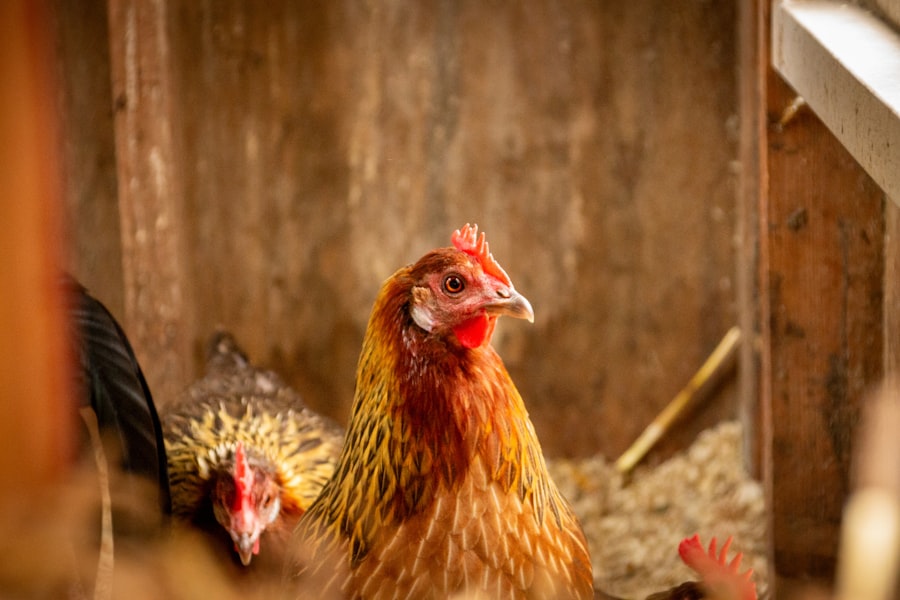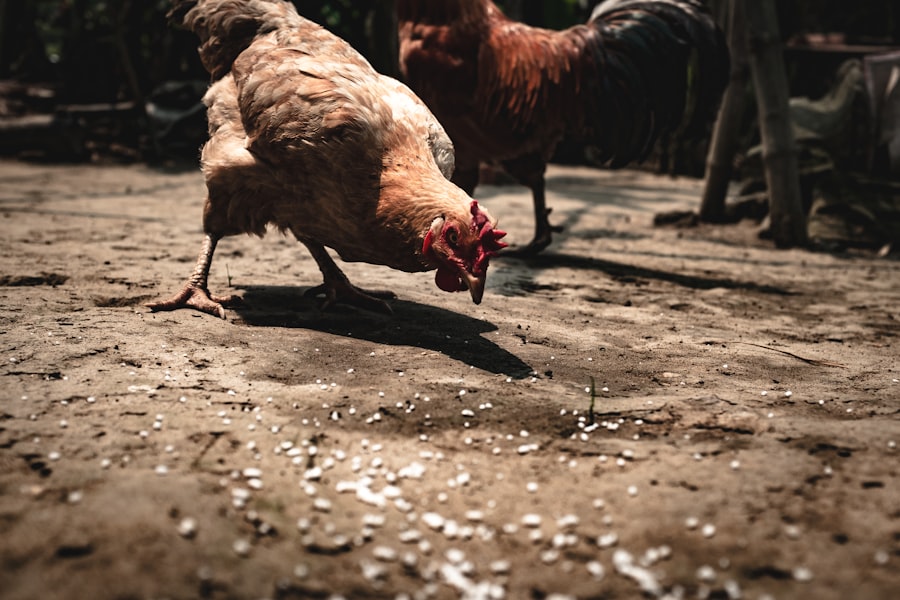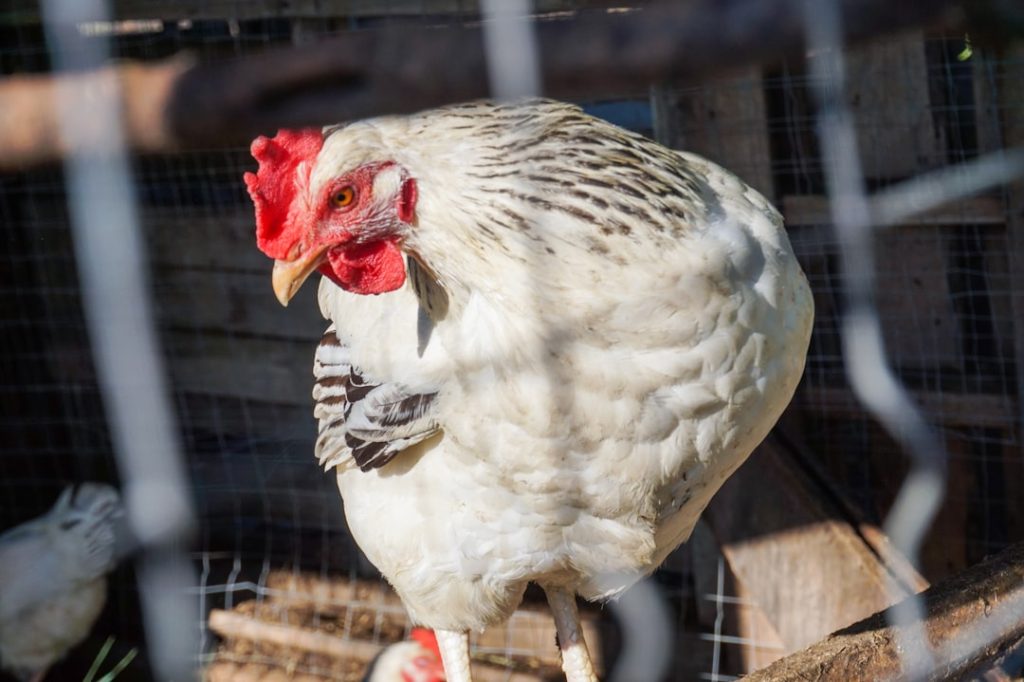Protecting free-range chickens from rain is essential for their health and welfare. Rain exposure can cause various health problems in chickens, including respiratory issues, hypothermia, and increased vulnerability to diseases. When chickens become wet, their feathers lose insulation properties, making it challenging for them to maintain proper body temperature.
This can result in hypothermia, particularly in young or elderly chickens. Furthermore, wet conditions create an environment conducive to bacterial and parasitic growth, elevating the risk of infections and illnesses. Chicken owners must recognize the negative effects of rain on free-range chickens and implement preventive measures to shield them from the elements.
Maintaining dry conditions for free-range chickens is crucial for both their physical and mental well-being. Chickens are weather-sensitive and may experience stress when subjected to extended periods of rain. Stress can lead to reduced egg production, behavioral problems, and a compromised immune system.
By providing adequate shelter and protection from rain, chicken owners can ensure their free-range chickens remain healthy, content, and productive. Understanding the importance of keeping free-range chickens dry is fundamental to developing effective strategies for protecting them from adverse weather conditions.
Table of Contents
- 1 Providing adequate shelter for free-range chickens
- 2 Creating a designated dry area for free-range chickens
- 3 Utilizing natural barriers to keep free-range chickens out of the rain
- 4 Implementing alternative solutions for keeping free-range chickens dry
- 5 Monitoring and adjusting the shelter and protection methods
- 6 Ensuring the health and well-being of free-range chickens in all weather conditions
- 7 FAQs
- 7.1 What are free-range chickens?
- 7.2 Why is it important to keep free-range chickens out of the rain?
- 7.3 How can I provide shelter for free-range chickens during rain?
- 7.4 What are some signs that free-range chickens are suffering from the rain?
- 7.5 Are there any specific breeds of chickens that are more resistant to rain?
Key Takeaways
- Keeping free-range chickens out of the rain is important for their health and well-being
- Adequate shelter is essential for protecting free-range chickens from the rain
- Creating a designated dry area for free-range chickens can help minimize their exposure to rain
- Natural barriers such as trees and shrubs can be utilized to keep free-range chickens out of the rain
- Implementing alternative solutions like tarps or awnings can provide additional protection for free-range chickens
Providing adequate shelter for free-range chickens
Constructing a Safe Haven
One of the most effective ways to keep free-range chickens out of the rain is by providing them with adequate shelter. A well-constructed coop or shelter can offer protection from the elements and create a safe and dry environment for chickens to seek refuge during rainy weather. The shelter should be spacious enough to accommodate all the chickens in the flock and should be equipped with proper ventilation to prevent moisture buildup.
Raised Shelters and Dry Roosting Areas
Additionally, the shelter should be raised off the ground to prevent flooding and provide a dry area for chickens to roost and rest. This ensures that the chickens have a comfortable and dry place to retreat to during rainy weather.
Cozy Nesting Boxes
In addition to a shelter, providing nesting boxes with ample bedding can offer chickens a cozy and dry place to lay their eggs and seek refuge from the rain. Nesting boxes should be placed in a covered area within the coop to ensure that eggs remain dry and clean.
Promoting Health and Well-being
By providing adequate shelter for free-range chickens, chicken owners can minimize the negative impact of rain on their flock and promote their overall health and well-being.
Creating a designated dry area for free-range chickens

In addition to providing a shelter, creating a designated dry area for free-range chickens can further protect them from the rain. This can be achieved by adding a covered run or enclosed area adjacent to the coop where chickens can roam and forage without being exposed to the elements. The covered run should be constructed with a solid roof and walls to provide maximum protection from rain and wind.
Additionally, adding a layer of dry bedding such as straw or wood shavings can create a comfortable and dry surface for chickens to walk on. Creating a designated dry area for free-range chickens not only offers protection from the rain but also promotes their natural behavior and well-being. Chickens are active foragers and enjoy spending time outdoors, even during inclement weather.
By providing a covered run, chicken owners can ensure that their free-range chickens have the opportunity to exercise and explore while staying dry and comfortable. Creating a designated dry area is an essential component of protecting free-range chickens from the negative effects of rain.
Utilizing natural barriers to keep free-range chickens out of the rain
In addition to providing shelter and creating designated dry areas, utilizing natural barriers can help keep free-range chickens out of the rain. Planting dense shrubs or trees around the perimeter of the coop and run can provide additional protection from wind and rain. These natural barriers can act as windbreaks and create a microclimate that is more sheltered and dry for chickens to roam in.
Additionally, planting vegetation can also provide shade during hot weather, creating a comfortable environment for free-range chickens year-round. Another natural barrier that can be utilized is the terrain itself. By strategically placing the coop and run on higher ground or sloped terrain, chicken owners can minimize the risk of flooding and create a drier environment for their flock.
Proper drainage should also be considered when designing the layout of the coop and run to prevent water accumulation during heavy rainfall. Utilizing natural barriers is an effective way to enhance the protection of free-range chickens from adverse weather conditions while promoting a natural and sustainable environment for them to thrive in.
Implementing alternative solutions for keeping free-range chickens dry
In addition to traditional shelter and natural barriers, there are alternative solutions that can be implemented to keep free-range chickens dry. One option is to use waterproof tarps or covers to protect outdoor areas where chickens roam and forage. These covers can be easily installed over the run or other outdoor spaces to provide temporary protection from rain and wind.
Waterproof tarps should be securely fastened to prevent them from being blown away by strong winds. Another alternative solution is to provide chickens with waterproof jackets or ponchos specifically designed for poultry. These jackets can offer additional protection from rain and help keep chickens warm and dry during inclement weather.
Waterproof jackets should be properly fitted to ensure that they do not restrict movement or cause discomfort for the chickens. Implementing alternative solutions for keeping free-range chickens dry can provide additional protection during periods of heavy rainfall or unexpected weather events.
Monitoring and adjusting the shelter and protection methods

Identifying Potential Issues
Regular inspections can help identify any potential issues such as leaks, damage, or areas that may need additional protection. This includes checking for signs of wear and tear, damage from predators, or areas where chickens may be escaping.
Preparing for Adverse Weather
In addition to regular inspections, monitoring weather forecasts can help chicken owners prepare for upcoming rain or adverse weather conditions. By staying informed about weather patterns, chicken owners can take proactive measures such as covering outdoor areas with tarps or providing additional bedding in the coop before a storm hits.
Minimizing the Impact of Rain
Adjusting shelter and protection methods based on weather forecasts can help minimize the impact of rain on free-range chickens and ensure that they remain comfortable and protected. By taking proactive measures, chicken owners can reduce the risk of health problems and ensure that their chickens remain safe and healthy.
Ensuring the health and well-being of free-range chickens in all weather conditions
Ultimately, ensuring the health and well-being of free-range chickens in all weather conditions requires a proactive approach that prioritizes their protection from rain and adverse weather. By understanding the negative impact of rain on chickens, providing adequate shelter, creating designated dry areas, utilizing natural barriers, implementing alternative solutions, monitoring and adjusting shelter methods, chicken owners can effectively protect their free-range flock from the elements. In addition to physical protection, it’s important for chicken owners to observe their flock’s behavior and overall well-being during rainy weather.
Monitoring for signs of stress, illness, or discomfort can help identify any issues that may arise as a result of exposure to rain. By taking a holistic approach to caring for free-range chickens, chicken owners can ensure that their flock remains healthy, happy, and resilient in all weather conditions. Prioritizing the health and well-being of free-range chickens is essential for sustainable and responsible chicken ownership.
If you’re looking for more tips on keeping your free-range chickens happy and healthy, check out this article on chicken coop portage. It offers valuable advice on how to design and maintain a coop that provides protection from the elements, including rain. With the right setup, you can ensure that your chickens have a comfortable and dry place to seek shelter when the weather turns bad. For more helpful resources on raising chickens, visit poultrywizard.com.
FAQs
What are free-range chickens?
Free-range chickens are poultry that are allowed to roam freely outdoors, rather than being confined to a coop or small enclosure. They have access to natural sunlight, fresh air, and a variety of plants and insects for foraging.
Why is it important to keep free-range chickens out of the rain?
Keeping free-range chickens out of the rain is important because prolonged exposure to wet conditions can lead to health issues such as respiratory infections, hypothermia, and other ailments. Wet feathers can also make chickens more susceptible to parasites and diseases.
How can I provide shelter for free-range chickens during rain?
You can provide shelter for free-range chickens during rain by setting up a covered area such as a simple roof or tarp over part of their outdoor space. This will give them a dry place to seek refuge from the rain while still allowing them to roam freely.
What are some signs that free-range chickens are suffering from the rain?
Signs that free-range chickens are suffering from the rain include huddling together, shivering, and seeking shelter under trees or other structures. Wet and droopy feathers, as well as a decrease in activity, can also indicate that the chickens are uncomfortable in the rain.
Are there any specific breeds of chickens that are more resistant to rain?
Some breeds of chickens, such as the Orpington and Sussex, are known for their hardiness and ability to withstand wet conditions. However, all chickens can benefit from having access to shelter during rain, regardless of their breed.
Meet Walter, the feathered-friend fanatic of Florida! Nestled in the sunshine state, Walter struts through life with his feathered companions, clucking his way to happiness. With a coop that’s fancier than a five-star hotel, he’s the Don Juan of the chicken world. When he’s not teaching his hens to do the cha-cha, you’ll find him in a heated debate with his prized rooster, Sir Clucks-a-Lot. Walter’s poultry passion is no yolk; he’s the sunny-side-up guy you never knew you needed in your flock of friends!







